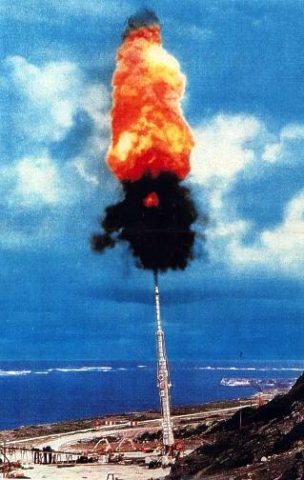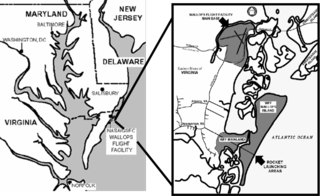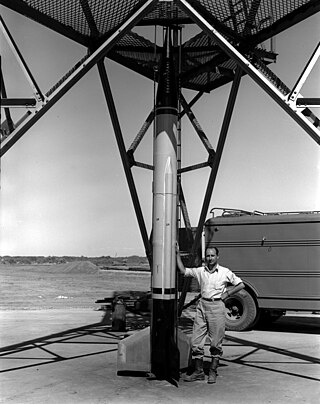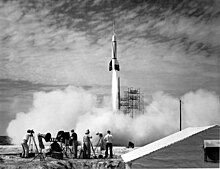
The Aerobee rocket was one of the United States' most produced and productive sounding rockets. Developed by the Aerojet Corporation, the Aerobee was designed to combine the altitude and launching capability of the V-2 with the cost effectiveness and mass production of the WAC Corporal. More than 1000 Aerobees were launched between 1947 and 1985, returning vast amounts of astronomical, physical, aeronomical, and biomedical data.

Project HARP, short for High Altitude Research Project, was a joint venture of the United States Department of Defense and Canada's Department of National Defence created with the goal of studying ballistics of re-entry vehicles and collecting upper atmospheric data for research. Unlike conventional space launching methods that rely on rockets, HARP instead used very large guns to fire projectiles into the atmosphere at extremely high speeds.

White Sands Missile Range (WSMR) is a United States Army military testing area and firing range located in the US state of New Mexico. The range was originally established in 1941 as the Alamogordo Bombing and Gunnery Range, where the Trinity test site lay at the northern end of the Range, in Socorro County near the towns of Carrizozo and San Antonio. It then became the White Sands Proving Ground on 9 July 1945.

A sub-orbital spaceflight is a spaceflight in which the spacecraft reaches outer space, but its trajectory intersects the surface of the gravitating body from which it was launched. Hence, it will not complete one orbital revolution, will not become an artificial satellite nor will it reach escape velocity.

Wallops Flight Facility (WFF) is a rocket launch site on Wallops Island on the Eastern Shore of Virginia, United States, just east of the Delmarva Peninsula and approximately 100 miles (160 km) north-northeast of Norfolk. The facility is operated by the Goddard Space Flight Center in Greenbelt, Maryland, and primarily serves to support science and exploration missions for NASA and other Federal agencies. WFF includes an extensively instrumented range to support launches of more than a dozen types of sounding rockets; small expendable suborbital and orbital rockets; high-altitude balloon flights carrying scientific instruments for atmospheric and astronomical research; and, using its Research Airport, flight tests of aeronautical research aircraft, including unmanned aerial vehicles.

The Aerojet General X-8 was an unguided, spin-stabilized sounding rocket designed to launch a 150 lb (68 kg) payload to 200,000 feet (61.0 km). The X-8 was a version of the prolific Aerobee rocket family.

Viking was a series of twelve sounding rockets designed and built by the Glenn L. Martin Company under the direction of the U.S. Naval Research Laboratory (NRL). Designed to supersede the German V-2, the Viking was the most advanced large, liquid-fueled rocket developed in the United States in the late 1940s, returning valuable scientific data from the edge of space between 1949 and 1955. Viking 4, launched in 1950, was the first sounding rocket to be launched from the deck of a ship.

Loki, officially designated 76mm HEAA Rocket T220, was an American unguided anti-aircraft rocket based on the German Taifun. Like the Taifun, Loki never saw service in its original role, but later found widespread use as a sounding rocket. It was so successful in this role that several advanced versions were developed on the basic Loki layout, including the final Super Loki.

The WAC Corporal was the first sounding rocket developed in the United States and the first vehicle to achieve hypersonic speeds. It was an offshoot of the Corporal program, that was started by a partnership between the United States Army Ordnance Corps and the California Institute of Technology in June 1944 with the ultimate goal of developing a military ballistic missile.

Arcas was the designation of an American sounding rocket, developed by the Atlantic Research Corp., Alexandria, Va.

Starfish Prime was a high-altitude nuclear test conducted by the United States, a joint effort of the Atomic Energy Commission (AEC) and the Defense Atomic Support Agency. It was launched from Johnston Atoll on July 9, 1962, and was the largest nuclear test conducted in outer space, and one of five conducted by the US in space.

The Air Force Missile Development Center and its predecessors were Cold War units that conducted and supported numerous missile tests using facilities at Holloman Air Force Base, where the center was the host unit.

The RTV-G-4 Bumper was a sounding rocket built by the United States. A combination of the German V-2 rocket and the WAC Corporal sounding rocket, it was used to study problems pertaining to two-stage high-speed rockets. The Bumper program launched eight rockets between May 13, 1948 and July 29, 1950. The first six flights were conducted at the White Sands Missile Range; the seventh launch, Bumper 8 on July 24, 1950, was the first rocket launched from Cape Canaveral.

The RTV-A-2 Hiroc was a product of the United States' first effort to develop an intercontinental ballistic missile (ICBM). The project was named MX-774. The project was canceled in 1947, but leftover funds were used to build and launch three of the planned 10 research vehicles designated RTV-A-2. The design included several innovations; the gimbaled thrust chambers provided guidance control, the internal gas pressure was used to support the airframe and the nose cap was separable. All of these concepts were later used on the Atlas missile and the first two on the Viking rocket. Also developed as part of MX-774 was the Azusa guidance system which was not used on the Hiroc missile but did contribute to the Atlas missile as well as many other early guided missiles launched from Cape Canveral.

Spaceflight as a practical endeavor began during World War II with the development of operational liquid-fueled rockets. Beginning life as a weapon, the V-2 was pressed into peaceful service after the war at the United States' White Sands Missile Range as well as the Soviet Union's Kapustin Yar. This led to a flourishing of missile designs setting the stage for the exploration of space. The small American WAC Corporal rocket was evolved into the Aerobee, a much more powerful sounding rocket. Exploration of space began in earnest in 1947 with the flight of the first Aerobee, 46 of which had flown by the end of 1950. These and other rockets, both Soviet and American, returned the first direct data on air density, temperature, charged particles and magnetic fields in the Earth's upper atmosphere.

Project Hermes was a missile research program run by the Ordnance Corps of the United States Army from November 15, 1944, to December 31, 1954, in response to Germany's rocket attacks in Europe during World War II. The program was to determine the missile needs of army field forces. A research and development partnership between the Ordnance Corps and General Electric started November 20, 1944 and resulted in the "development of long-range missiles that could be used against both ground targets and high-altitude aircraft."

USS Desert Ship (LLS-1) is a concrete blockhouse providing assembly and launch facilities simulating shipboard conditions for Navy surface-to-air weapons testing at the Naval Air Warfare Center (NAWC) Weapons Division – White Sands.
The White Sands Test Center (WSTC) is responsible for planning and conducting tests at White Sands Missile Range (WSMR), New Mexico, USA. WSTC reports to the United States Army Test and Evaluation Command (ATEC). WSMR is designated as an activity within the Department of Defense (DoD) Major Range and Test Facility Base (MRTFB), a core set of DoD Test and Evaluation (T&E) infrastructure and workforce preserved as a national asset to support the DoD acquisition system. The Range possesses capabilities and infrastructure utilized by the US Army, Navy, Air Force and other government agencies as well as universities, private industry, and foreign militaries. As a tri-service facility, WSTC supports the Army by providing data collection and analysis, instrumentation development, modeling and simulation, research assessment, and technical services.

Albert II was a male rhesus macaque monkey who was the first primate and first mammal in space. He flew from Holloman Air Force Base in New Mexico, United States, to an altitude of 83 miles aboard a U.S. V-2 sounding rocket on June 14, 1949. Albert died upon reentry after a parachute failure caused his capsule to strike the ground at high speed. Albert's respiratory and cardiological data were recorded up to the moment of impact.
Albert I was a rhesus macaque monkey and the first mammal launched on a rocket on June 18, 1948. The launch was staged at White Sands Proving Ground, Las Cruces, New Mexico. Albert I, a nine-pound monkey, was anesthetized and placed inside the rocket's crew capsule in the nose of the V-2 rocket. The flight did not reach outer space.



















